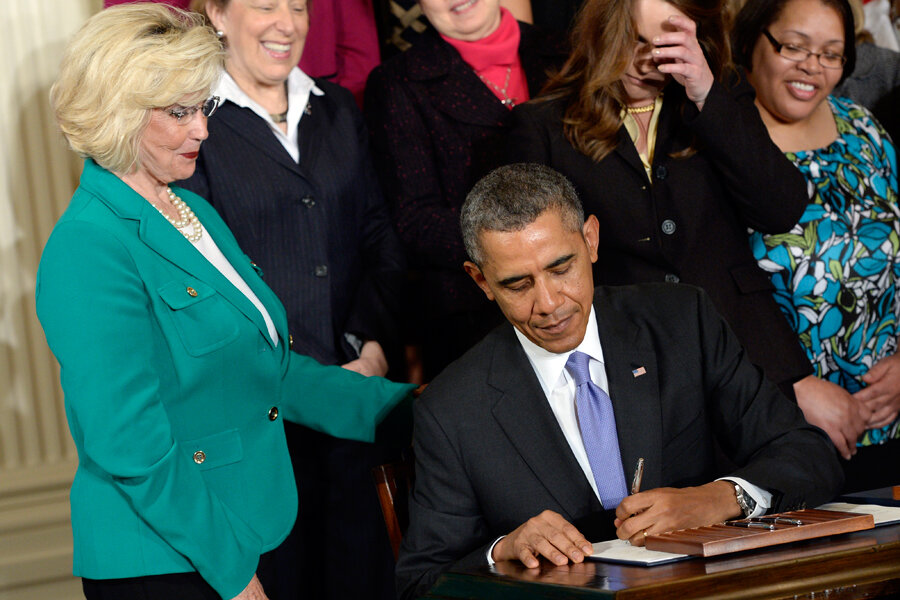Does White House have a gender pay gap? How the numbers stack up.
Loading...
In the latest round in a long, bitter duel between Democrats and Republicans over which party is more on the side of women voters, White House press secretary Jay Carney was hit with questions on Monday from reporters about a report finding that the salary for the average median White House female staffer is about 12 percent lower than that for a male staffer.
The median woman working in the White House makes about $65,000, almost $9,000 less than her male counterpart, according to the report from the American Enterprise Institute (AEI), a conservative group. That difference divides out to women in the White House making about 88 cents for each dollar that men in the administration make, the report said.
The report is not new: In fact, it was released in January. But it is back and getting tossed like a hot potato to Democrats – just as President Obama is observing National Equal Pay Day on Tuesday by signing two executive orders that address the gender pay gap.
It is also getting talked about amid a midterm season in which Democrats have sought to peg Republicans as tone-deaf to women’s issues, including equal pay as well as reproductive rights and child care. That has put Republicans on the defensive in courting the women voters who helped put Mr. Obama in office.
At the press conference, Mr. Carney said that men and women who work the same White House jobs make the same salaries. The pay difference results from the fact that women outnumber men in the administration’s lower-level jobs, he said. Some studies have shown that women are more likely than men to take jobs with flexible or part-time hours and with low wages.
Ten of the administration’s 16 department heads, Carney noted, are women, and each of them makes $172,200, the top annual wage at the White House.
Still, the White House has been criticized for not doing more to even out a gender imbalance: A report from the Center for American Women and Politics, cited in The New York Times, found that Obama’s cabinet is 35 percent female, down from 41 percent during the Clinton administration (but up from 24 percent under George W. Bush).
Carney also noted that the 88 cents figure is much better than the national average: Women overall make 77 cents for each dollar that men make, according to data from the Bureau of Labor Statistics.
But that statistic has itself been questioned: Some Republicans have said that the gender pay gap has been exaggerated, characterizing the pay issue as a political rallying cry but not necessarily a real problem.
On Monday, two scholars from AEI published an op-ed in The Wall Street Journal calling the 77 cents statistic “misleading” and “illogical” and arguing that almost the entire pay gap can be attributed to some women entering lower-paying fields or electing to work shorter hours.
Yet even more-cautious statistics support the existence of a gender pay gap. If differences in hours worked are factored into the equation, women make about 86 percent of what men make, according to the Bureau of Labor Statistics. And the American Association of University Women has said that the gap between male and female earnings is still about 7 percent even if differences in work hours, experience levels, college majors, occupations, and other factors are considered.
Obama, who carried women voters by about 11 percentage points in the 2012 election, on Tuesday signed an executive order barring federal contractors from "retaliating against employees who discuss their compensation.” The aim is to help workers, especially women, find out what their co-workers are earning and assess if they’re getting the wages to which they’re entitled.
The second order requires federal contractors to file reports with the Department of Labor that break down the wages they pay their employees by both race and sex.
“Unfortunately, pay inequity is a real and persistent problem that continues to shortchange women, their families, and our economy as a whole,” White House senior adviser Valerie Jarrett told reporters.
The administration noted on Tuesday that the first law the president signed after taking office in 2009 was the Lilly Ledbetter Fair Pay Act, which extended the length of time that employees have to file claims to recoup wages lost because of discrimination. The bill’s namesake, Ms. Ledbetter, was expected to be present for the signing of the two new executive orders in the White House’s East Room.
Meanwhile, the US Senate is expected this week to consider the Paycheck Fairness Act, a bill that would prohibit all employers, in addition to federal contractors, from retaliating against workers who discuss their pay. The bill is not expected to get past Republican lawmakers.
Kirsten Kukowski, Republican National Committee spokeswoman, said in a statement that while Republicans "support equal pay for equal work," the party does not support the proposed legislation, calling it a “desperate political ploy” from Democrats that would not bring about real change on the issue.
“Real solutions,” she said, would “focus on job creation and opportunity for women."








